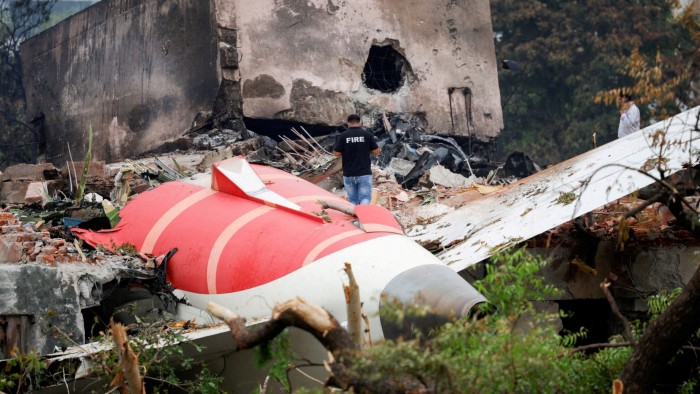Unlock the Editor’s Digest for free
Roula Khalaf, Editor of the FT, selects her favourite stories in this weekly newsletter.
The Boeing Dreamliner jet in last week’s deadly Air India crash had a “clean history” and two recently serviced engines, the airline’s chair has said, as an investigation into the country’s worst air disaster in almost three decades gets under way.
N Chandrasekaran, who is also chair of the carrier’s owner, Tata Group, pushed back on “speculations” about what caused the London-bound flight to crash a minute after take-off in Ahmedabad last Thursday, adding that preliminary results from an investigation could take a month.
“There are speculations about human error, speculations about airlines, speculations about engines, maintenance, all kinds,” Chandrasekaran told India’s Economic Times in an interview published late on Wednesday.
“But the fact that I know so far is this particular aircraft, this specific tail, AI-171 has a clean history,” he said, referring to Air India Flight 171. All but one of 242 people on board the flight were killed, along with dozens more in a medical college where the plane crashed.
The Dreamliner’s right engine was a “new engine” installed in March, while its left engine — whose installation date Chandrasekaran did not give — was serviced in 2023 and due for its next maintenance check in December, said the Air India chair.
“Both engine histories are clean,” he said.
Sumeet Sabharwal, the captain, had more than 11,500 hours of flying experience, while first officer Clive Kunder, had more than 3,400 hours, said Chandrasekaran.
“What I hear from colleagues is that they were excellent pilots and great professionals,” he said. “So we can’t jump to any conclusions.”
India’s Aircraft Accident Investigation Bureau is leading the probe, along with its UK and US counterparts. Fifty-three British citizens were on board the flight, including sole surviving passenger Vishwash Kumar Ramesh.
Boeing and GE Aerospace, which made the plane’s engines, are co-operating. Chandrasekaran said he had been in touch with both companies “at the highest levels”. This is the first fatal accident involving a Dreamliner.
The AAIB is analysing the plane’s black boxes and has yet to comment on its findings. Aviation analysts who have studied video footage of the flight said the jet’s ram air turbine, an emergency device for events such as electrical or engine failure, appeared to be deployed after take-off.
Air India on Wednesday said it would cut long-haul services by 15 per cent, citing enhanced safety checks ordered by authorities and restrictions on airspace because of the conflict in the Middle East. It said most of these inspections had been concluded, giving it “reassurance in the safety measures and procedures that we follow”.
The accident has presented Tata, which bought the airline out of state ownership in 2022, with one of the worst crises in its recent history. Singapore Airlines acquired a 25 per cent stake in Air India after its joint venture with Tata, Vistara, was absorbed in a merger last year.
Chandrasekaran said Air India’s 33 Dreamliners were serviced by an Indian engineering company, along with a subsidiary of the Singaporean carrier.
In a post on social media platform X on Wednesday, Praful Patel, a former Indian civil aviation minister, questioned Singapore Airlines’ “deafening silence” on the crash, claiming: “They seem to be in hiding.”
However, Singapore Airlines had shared a statement of condolence with media on the day of the crash.
“The Singapore Airlines (SIA) Group extends our deepest condolences to the families and loved ones of everyone affected by the devastating Air India flight AI171 accident,” the airline reiterated in a statement to the Financial Times.
Chandrasekaran said Goh Choon Phong, the group’s chief executive, had been “in constant touch” with him.
“Since we took over [Vistara], they have helped us in many dimensions,” he told the Economic Times. “Even some of the safety procedures, the best processes, we have taken from Singapore Airlines.”
Read the full article here
